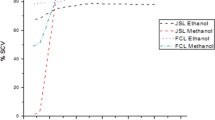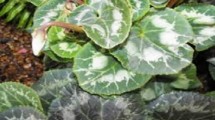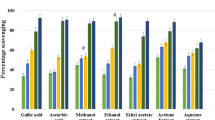Abstract
This study was performed to evaluate the anticancer, antioxidant, and antimicrobial activities of fractions and isolated compounds from anemone (Anemone cathayensis). Fourteen compounds were isolated from extracts. Anticancer activities of fractions and compounds were determined by MTT assay, and all tested fractions showed inhibition activity on human breast cancer cells (MDA-MB-231). The fraction 6 displayed the strongest anticancer activity, and inhibition percent was 50.32%. The antioxidant effect of fractions was evaluated by using DPPH scavenging assays. Fraction 5 had a higher DPPH radical scavenging activity with low IC50 value of 30.578 μg/mL. The antimicrobial activity of the fractions was evaluated against 3 microorganisms using the agar well diffusion method. The fractions also showed moderate antimicrobial activity. These results suggest that anemone could hold a good potential source for human health.
Similar content being viewed by others
References
Mehta S, Rai PK, Rai DK, Rai NK, Rai AK, Bicanic D, Sharma B, Watal G. LIBS-based detection of antioxidant elements in seeds of Emblica officinalis. Food Biophys. 5: 186–192 (2010)
Rai PK, Jaiswal D, Rai DK, Sharma B, Watal G. Antioxidant potential of oral feeding of Cynodon dactylon extract on diabetes induced oxidative stress. J. Food Biochem. 34: 78–92 (2010)
Sharma RK, Chatterji S, Rai DK, Mehta S, Rai PK, Singh RK, Watal G, Sharma B. Antioxidant activities and phenolic contents of the aqueous extracts of some Indian medicinal plants. J. Med. Plants Res. 3: 944–948 (2009)
Flora of China Editorial Committee of Chinese Academy of Sciences. Flora of China. Vol. 30. Science Press, Beijing, China. p. 54 (2004)
Lu JC, Xu BB, Zhang XY, Sun QS. Study on chemical constituents of rhizome of Anemone raddeana. Acta Pharm. Sin. 37: 709–712 (2002)
Xia ZT, Liu DY, Wang XY, Liu KF, Zhang PC. Studies on the chemical constituents of the rhizoma of Anemone raddeana Regel. Acta Chim. Sinica 62: 1935–1940 (2004)
Zhang QW, Ye WC, Che CT, Zhapo SX. Studies on the chemical constituents from Anemone anhuiensis YK Yang N. Wang et W. C. Ye. China J. Chinese Mater. Med. 9: 36–38 (2001)
Liao X, Chen YZ, Ding LS, Li BG. Chemical constituents from Aanemone rupestris ssp. Gelida. Natural Product Res. Develop. 4: 1–6 (1999)
Wang MK, Ding LS, Wu FE. Antitumor effects of raddeanin A on S180, H22, and U14 cell xenografts in mice. Chinese J. Cancer 27: 910–913 (2008)
Peng SL, Liao X, Wang FT, Ding LS. Antitumor effect of the saponins from Anemone davidii. Natural Product Res. Develop. 5: 60–62 (2001)
Khan N, Hadi N, Afaq F, Syed DN, Kweon MH, Mukhtar H. Pomegranate fruit extract inhibits prosurvival pathways in human A549 lung carcinoma cells and tumor growth in athymic nude mice. Carcinogenesis 28: 163–173 (2007)
Kirby AJ, Schmidt RJ. The antioxidant activity of Chinese herbs for eczema and of placebo herbs — I. J. Ethnopharmacol. 56: 103–108 (1997)
Fan ZL, Wang ZY, Cheng CL, Zhao HT, Zhang H. Antioxidant and antiproliferative activities of five wild berries. Food Sci. 31(17): 148–152 (2010)
Song Q, Chai QY, Zhang LW. In vivo anti-tumor activity of total saponins from Asparagus officinalis. Food Sci. 31(13): 273–275 (2010)
Liu J, David GP, Jing H. Hawthorn flavonoid extract: Antioxidant activity and growth inhibition effect on cancer cells. Food Sci. 31(3): 220–223 (2010)
Coughlin SS, Ekuweme DU. Breast cancer as a global health concern. Cancer Epidemiol. 33: 315–318 (2009)
Sharma V. A polyphenolic compound rottlerin demonstrates significant in vitro cytotoxicity against human cancer cell lines: Isolation and characterization from the fruits of Mallotus philippinensis. J. Plant Biochem. Biotechnol. 20: 190–195 (2011)
Allouche Y, Warleta F, Campos M, Sanchez-Quesada, C, Uceda M, Beltran G, Gaforio JJ. Antioxidant, antiproliferative, and proapoptotic capacities of pentacyclic triterpenes found in the skin of olives on MCF-7 human breast cancer cells and their effects on DNA damage. J. Agr. Food Chem. 59: 121–130 (2011)
Finkel T, Holbrook NJ. Oxidants, oxidative stress, and the biology of ageing. Nature 408: 239–247 (2000)
Wu XJ, Hansen C. Antioxidant capacity, phenolic content, and polysaccharide content of Lentinus edodes grown in whey permeate-based submerged culture. J. Food Sci. 73: 1–8 (2008)
Hsouna AB, Trigui M, Culioli G, Blache Y, Jaoua S. Antioxidant constituents from Lawsonia inermis leaves: Isolation, structure elucidation, and antioxidative capacity. Food Chem. 125: 193–200 (2011)
Erkana N, Cetinb H, Ayranci E. Antioxidant activities of Sideritis congesta Davis et Huber-Morath and Sideritis arguta Boiss et Heldr: Identification of free flavonoids and cinnamic acid derivatives. Food Res. Int. 44: 297–303 (2011)
Hseu YC, Chen SC, Yechd YJ, Wang L, Yang HL. Antioxidant activity of Antrodia camphorate on free radical-induced endothelial cell damage. J. Ethnopharmacol. 118: 237–245 (2008)
Cho ML, Lee HS, Kang IJ, Wond MH, You SG. Antioxidant properties of extract and fractions from Enteromorpha prolifera, a type of green seaweed. Food Chem. 127: 999–1006 (2011)
Cui Yh, Zhang KC. Assessment of in vitro antioxidant activity of a triterpenoidal saponin from Ganoderma lucidum fruit bodiese). Food Sci. 31(19): 49–53 (2010)
Murthy PS, Manonmani HK. Physico-chemical, antioxidant, and antimicrobial properties of Indian monsooned coffee. Eur. Food Res. Technol. 229: 645–650 (2009)
Liao X, Li BG, Gao XP, Guan JF, Ding LS, Chen YZ. Bioactive triterpenoid saponins from Anemone davidii. Chinese Trad. Herbal Drugs 32(6): 15–18 (2001)
Kim H, Choi HK, Moon JY, Kim YS, Mosaddik A, Cho SK. Comparative antioxidant and antiproliferative activities of red and white pitayas and their correlation with flavonoid and polyphenol content. J. Food Sci. 76: 38–45 (2011)
Author information
Authors and Affiliations
Corresponding author
Rights and permissions
About this article
Cite this article
Wang, Jl., Liu, K., Gong, Wz. et al. Anticancer, antioxidant, and antimicrobial activities of anemone (Anemone cathayensis). Food Sci Biotechnol 21, 551–557 (2012). https://doi.org/10.1007/s10068-012-0070-9
Received:
Revised:
Accepted:
Published:
Issue Date:
DOI: https://doi.org/10.1007/s10068-012-0070-9




